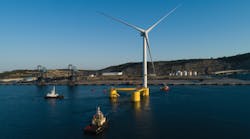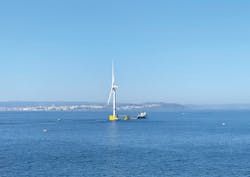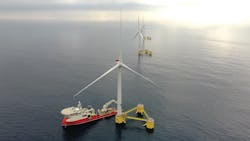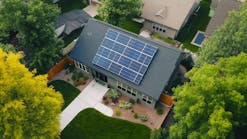In recent years, a number of countries have adopted offshore wind farms in view of their numerous advantages over onshore wind farms. Namely, their higher wind speeds, more prevalent wind conditions and reduction in land use. However, offshore wind farms are subject to disadvantages in the form of construction damage to the seabed and the need for costly subsea cable connections between each wind turbine and landfall.
Portugal has led the way in opting for a new approach to offshore wind farms. It developed the offshore WindFloat Atlantic (WFA) wind farm, considered to be continental Europe’s first offshore floating wind farm. This project offers a significant contribution toward achieving two of the 2020 climate and energy targets established by the European Renewable Energy Directive in 2018. This project is set to reduce both greenhouse gas emissions and boost the development of renewable energy resources.
Floating Platforms
The WFA wind farm comprises three wind turbines supported by three semisubmersible floating structures, a design based on the WindFloat technology developed by Principle Power Inc. The technology expands on oil rig platform principles and applies them to offshore wind energy. Some main features set this technology apart:
- It enables multimegawatt wind turbines to be installed at depths of greater than 50 m (164 ft).
- Each wind turbine operates on top of a floating platform moored to the seafloor by cables and chains, guaranteeing its stability.
- This system eliminates the need for the complex offshore operations involved in building traditional fixed structures, thus reducing its environmental impact.
- The platform and wind turbine are assembled at port and later towed to their final location.
These features eliminate the need to use large ships for transportation, which are slower and more expensive.
One of the new features of this technology is the type of platform: They are triangular, semisubmersible and moored to the seafloor. Each platform has three interconnected vertical columns, and the wind turbine tower is fixed to one of these. Their stability is reinforced by a gate system that fills the base of the three pillars with water, combined with a static and active ballast system. Following is a more detailed description of the platform’s structure and operation:
- Each of the three columns is 29 m (95.2 ft) high and 12 m (39.4 ft) in diameter. The columns are laid out in the shape of an equilateral triangle with a length of 53 m (173.9 ft), providing the buoyancy to support the wind turbine.
- Horizontal plates are located at the base of the columns to increase the structure’s inertia and limit movements from excessive wave heights created by offshore storms. These plates are fastened to the columns by tubular metal structures.
- Consisting of water at the bottom of columns, static ballast increases the structure’s draft and reduces the materials used to build it.
- Located in the upper half of each column, active ballast distributes water between the columns to offset the stress exerted by the force of wind against the wind turbine. Its purpose is to maintain the wind turbine in a vertical position to optimize its performance.
- Platforms can transfer up to 200 tons of ballast in approximately 30 minutes. This technique consists of using redundant pumping systems operating on two independent flow routes.
- Platforms are designed to withstand a scenario in which the active ballast system is nonoperational and all the water is in the compartment, causing the structure to lean to the side.
- The 11-m (36.1-ft) height of the upper section of columns is calculated so the crests of the highest waves cannot damage equipment.
- The platform is moored to the seafloor by three mooring lines made of conventional components, namely drag embedment anchors, chains and cables. Each line is connected to one of the columns.
- Each line, of varying length, has multiple segments of chain and cable. The lines are connected to the base of the floating structure’s columns and mainly settle on the seafloor.
Earlier offshore wind farms have now been in commission for almost 20 years, and decisions will need to be made soon about the economic viability of extending their lifetime. Consideration needs to be given to the routine maintenance undertaken and fault repairs conducted during their service life as well as the structural stability of the wind turbines and site environmental operating conditions.
The platforms used in the WFA are designed and certified to have an economic life span of 25 years as well as the following:
- Designed to withstand storms with a recurrence period of 50 years and a fatigue life of at least a quarter century.
- The rust protection of the structure and mooring system requires rigorous inspection and repainting or anodizing after 25 years.
In accordance with the standards of the International Association of Marine Aids to Navigation and Lighthouse Authorities (IALA), the emerged portion of the structure is colored yellow. A rectangular implementation and protection zone, measuring 4.5 km by 2.5 km (2.79 miles by 1.55 miles), has been set up around the wind farm.
Wind Turbines
One of the main advantages of the WindFloat technology is it can be adapted to any wind turbine available on the market, as its structure is like that of onshore wind turbines. In this case, the maximum vertical distance between the base and the shaft is 96 m (315 ft), and the vertical distance between the water’s surface and the rotor shaft is 107 m (351 ft). The rotor diameter is 164 m (538 ft), corresponding to a swept area of 21,124 sq m (227,294 sq ft). These are the largest wind turbines ever installed on floating platforms to date.
The wind turbines’ aviation lighting complies with the requirements of the Portuguese Civil Aviation Authority with intermittent white light during the day and a permanent red light at night, visible by 360 degrees surrounding the platform.
Subsea Cable Interconnection
WFA is located 20 km (12.43 miles) off the coast of Viana do Castelo, in an area of the Atlantic Ocean around 95 m (312 ft) deep. The wind farm has an installed capacity of 25 MW and is composed of three wind turbines each having a nominal capacity of 8.4 MW. Each wind turbine is equipped with 0.64/60-kV transformers and — based on the long-term records of the wind regime in the area — an availability of 34% is predicted, resulting in an estimated annual power generation of 74.5 GWh by the wind farm.
The generated energy is transported along the seabed through a subsea cable installed between the wind farm turbines and the land through the north dock at the Port of Viana do Castelo.
The wind turbines are installed 600 m (1969 ft) apart and connected to each other by 14.741-sq mm (0.023-sq inches), 60-kV three-phase copper-cored ac dynamic cables. The wind turbine closest to shore is connected with one of these dynamic cables to the submarine dry mate connector (DMC) — the property of the Portuguese transmission system operator (TSO), Rede Elétrica Nacional S.A. — at a distance of 300 m (984.5 ft) from the first wind turbine. The TSO’s submarine electrical cable links the DMC to its onshore switchyard by the coast and then onward to the Portuguese distribution network at the 60/15-kV Monserrate substation.
The method selected to lay the submarine cables were based on geological and metocean studies, analyzing also the risks associated with current fishing methods used along the cable’s path as well as maritime traffic. Sections of the TSO’s export cable are buried under the seabed, which is mostly sandy. This is achieved by employing a jetting system, a technology whereby jets of high-pressure water cut a trench with the right width and depth so the cable’s own weight is used to bury the cable. The seabed sediment displaced and stirred up during this process returns to the seabed because of gravity and covers the cable.
Along the sections of the cable route where rocky material was encountered, the export cable was placed on top of the rocks and its permanent position was guaranteed by depositing inert materials with the correct granulometry on top of the cable. The installation of these carabineers attached to the rock, or the installation of these support beds, were premanufactured off-site.
The submarine cables were designed with additional protective screening layers surrounding the conductor core to reduce effects of the electromagnetic field. Furthermore, a corridor approximately 500 m (1640 ft) wide was created and granted to the Portuguese transmission system operator to set up the bed for installing its cable.
Constructing The Platforms
The construction process started in 2018, using a dry dock to manufacture and assemble two platforms, with a few relevant aspects:
- Columns were manufactured in parts, transported to the shipyard and assembled in an area close to the Lisnave dry dock in Setúbal, Portugal.
- The lattice was made in a factory and transported in sections by land to the shipyard.
- Once the columns and lattice were assembled separately, they were placed in the dry dock for assembly.
- The dry dock was flooded when each structure was complete. Therefore, the platforms floated and could be weighted down until conventional tugboats entered the area to secure them to the structure and tow it out of the dry dock, by sea, to the outer Port of Ferrol, Spain.
At the same time in 2018, a third platform was being built at the shipyard of Fene, Spain, near Ferrol. A significant difference was the absence of a dry dock; therefore, the structure was finished being assembled at quayside and then transported by a barge to the outer Port of Ferrol.
On the dock of the Port of Ferrol, each wind turbine was mounted on its platform, achieving a draft of between 12 m and 14 m (39 ft and 46 ft), and the pre-commissioning of the wind turbines was carried out. Once the installation of each wind turbine was complete, the platform was transported from the Port of Ferrol to the location of the offshore wind farm, where the mooring systems previously had been put in place.
Power Supply Goes Live
On Dec. 31, 2019, the first wind turbine was connected to the grid, after connecting the mooring cables to the platform as well as connecting and testing all the electrical cable sections between the wind turbine and the onshore substation.
By mid-July 2020, the three wind turbines were generating and supplying green energy to the grid. Currently, the wind farm generates sufficient energy to supply the needs of 16,000 households per year. It also is a powerful weapon against climate change and can save some 1.1 million tons in carbon dioxide emissions during the same period.
Maintaining WFA
The original equipment manufacturer of the wind turbines remains responsible for their maintenance, whereas Principle Power is responsible for maintaining the floating platforms. Maintenance operations are divided into two main categories: maintenance on the offshore platforms and major repairs.
The first of these consists of corrective and preventive maintenance activities as well as monitoring each platform’s condition, without the need to tow the platforms. The latter, because of the nature and size of the components involved, requires the entire platform-wind turbine complex to be towed to a port for repair. An example of this is the replacement of key structural components, such as the generator or blades, if necessary.
To avoid unscheduled activities, the performance of the platforms and wind turbines is monitored remotely on a continuous basis. In this way, the monitoring process minimizes power generation outages. Preventive maintenance operations are carried out annually and include activities such as inspections, revisions and maintenance of ballast systems or the power supply. On the other hand, corrective maintenance consists mainly of disassembling and replacing a broken device or structure. When it is possible to repair them, devices are repaired on land and assembled on the platform once again. Offshore intervention time is reduced by following this approach.
Interventions on wind turbines carried out in situ can be preventive (scheduled) or corrective (scheduled or unscheduled). The former ensures optimal operation can be planned to minimize the effect of stoppages on energy production. This usually consists of an annual general inspection with a duration of approximately three days per turbine. To minimize the impact of unscheduled activities, wind turbines also are equipped with powerful predictive state monitoring systems.
Investment And Employment
The WFA project provided a vector of growth and job creation in Portugal and Spain, although its economic impacts will continue to be observed over the long term. It involved an investment of approximately €120 million ($US 141 million), made by the companies that own Windplus S.A. — EDP Renováveis (54.4%), Engie (25%), Repsol (19.4%) and Principle Power (1.2%).
The Portuguese carbon dioxide emissions reduction fund supported the project with incentives, and the European Investment Bank provided a loan of €60 million ($US 70.3 million). More than 500 highly skilled employees were engaged in this project.





